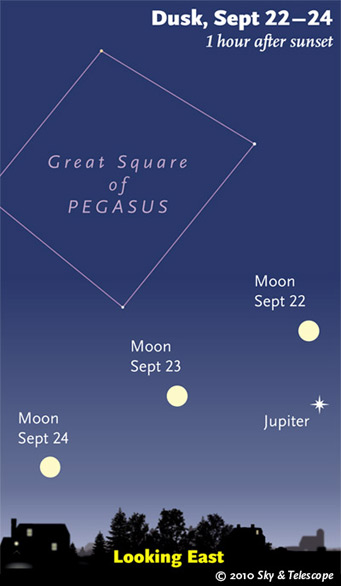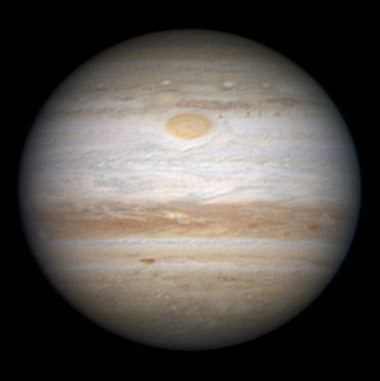
Watch the Moon at opposition pass Jupiter close to opposition.
Sky & Telescope diagram
Friday, Sept. 17
Saturday, Sept. 18
Sunday, Sept. 19
Monday, Sept. 20
Tuesday, Sept. 21
Wednesday, Sept. 22
Thursday, Sept. 23
Friday, Sept. 24
Saturday, Sept. 25
Want to become a better amateur astronomer? Learn your way around the constellations. They're the key to locating everything fainter and deeper to hunt with binoculars or a telescope.
For an easy-to-use constellation guide covering the whole evening sky, use the big monthly map in the center of each issue of Sky & Telescope, the essential magazine of astronomy. Or download our free Getting Started in Astronomy booklet (which only has bimonthly maps).
Sky Atlas 2000.0 (the color Deluxe Edition is shown here) plots 81,312 stars to magnitude 8.5. That includes most of the stars that you can see in a good finderscope, and typically one or two stars that will fall within a 50× telescope's field of view wherever you point. About 2,700 deep-sky objects to hunt are plotted among the stars.
Alan MacRobert
Once you get a telescope, to put it to good use you must have a detailed, large-scale sky atlas (set of charts). The standards are the Pocket Sky Atlas, which shows stars to magnitude 7.6; the larger Sky Atlas 2000.0 (stars to magnitude 8.5); and the even larger and deeper Uranometria 2000.0 (stars to magnitude 9.75). And read how to use your charts effectively.
You'll also want a good deep-sky guidebook, such as Sky Atlas 2000.0 Companion by Strong and Sinnott, or the more detailed and descriptive Night Sky Observer's Guide by Kepple and Sanner, or the classic if dated Burnham's Celestial Handbook.
Can a computerized telescope take their place? I don't think so — not for beginners, anyway, and especially not on mounts that are less than top-quality mechanically. As Terence Dickinson and Alan Dyer say in their Backyard Astronomer's Guide, "A full appreciation of the universe cannot come without developing the skills to find things in the sky and understanding how the sky works. This knowledge comes only by spending time under the stars with star maps in hand."
This Week's Planet Roundup
Mercury is coming into a fine morning apparition this week, brightening from magnitude 0.0 to –0.8. Look for it low in the east about 45 minutes before your time of sunrise. Look too for little Regulus twinkling above or upper right of it, higher every morning.
Venus, though brightest now at magnitude –4.8, is sinking quite low in the southwest during bright twilight. It sets before dark.
Mars, vastly dimmer at magnitude +1.5, is 6° or 7° to Venus's upper right all week. Use binoculars; good luck.

Right on schedule, Jupiter's Great Red Spot (GRS) was crossing the planet's central meridian when Christopher Go in the Philippines took this image at 15:29 UT Sept. 16, 2010. Just to its upper left is pale Red Spot Junior (Oval BA), which has finally passed the GRS with no apparent effect on either. Notice too the pale hints of the South Equatorial Belt coming back into view, including the dent in it below the GRS known as the Red Spot Hollow. On the other side of the equator, the North Equatorial Belt is full of busy activity. South is up.
Christopher Go
Jupiter (magnitude –2.9, in Pisces) is at opposition this week. As twilight fades, Jupiter becomes visible low in the east. It's well up in the east-southeast by mid-evening — by far the brightest starlike point in the sky. It's highest in the south around 1 a.m. daylight saving time.
Jupiter is having an unusually close apparition; from now through mid-October it appears 49 arcseconds wide. In fact, at opposition on the night of Monday the 20th Jupiter will be closer than at any other time from 1963 to 2022. However, that's only 1% or 2% closer than in any year when opposition occurs from mid-August through October, including last year and next. See our article.
Jupiter's Great Red Spot is near System II longitude 157°. Assuming it stays there, here's a list to print out of all the Great Red Spot's predicted transit times (in UT) for the rest of this observing season.
Saturn is hidden behind the glare of the Sun.
Uranus (magnitude 5.7) is only about 1° from Jupiter this week. They're closest (0.8°) on the 17th and 18th, with Uranus passing north of Jupiter. Photo on SpaceWeather.com.
Neptune (magnitude 7.8, at the Aquarius-Capricornus border) is well placed earlier in the evening. See our finder charts for Uranus and Neptune online or in the September Sky & Telescope, page 56. Can you see any color in Uranus and/or Neptune?
Pluto (magnitude 14, in northwestern Sagittarius) is in the south-southwest after dusk, but with the bright moonlight this week, forget it.
All descriptions that relate to your horizon or zenith — including the words up, down, right, and left — are written for the world's mid-northern latitudes. Descriptions that also depend on longitude (mainly Moon positions) are for North America. Eastern Daylight Time (EDT) equals Universal Time (also known as UT, UTC, or GMT) minus 4 hours.
To be sure to get the current Sky at a Glance, bookmark this URL:
http://SkyandTelescope.com/observing/ataglance?1=1
If pictures fail to load, refresh the page. If they still fail to load, change the 1 at the end of the URL to any other character and try again.
 0
0
Comments
You must be logged in to post a comment.